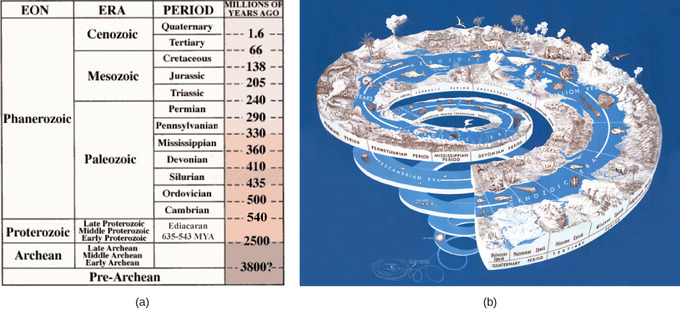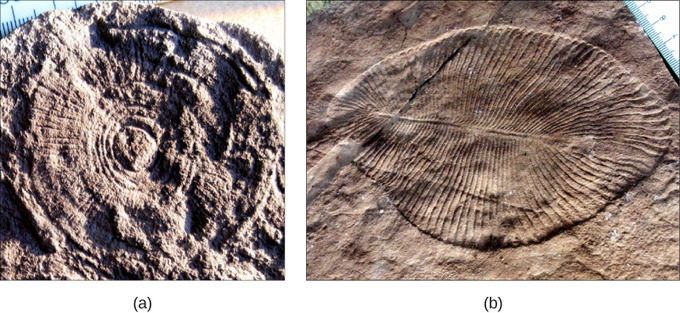27.4A: Pre-Cambrian Animal Life
- Page ID
- 13699
Early animal life (Ediacaran biota) evolved from protists during the pre-Cambrian period, which is also known as the Ediacaran period.
- Describe the types of animals found in the Ediacaran period
Key Points
- The pre-Cambrian period ( Ediacaran period ) took place between 635-543 million years ago.
- Early animal life, called Ediacaran biota, evolved from protists; it was previously believed early animal life included only tiny, sessile, soft-bodied sea creatures, but scientific evidence suggests more complex animals lived during this time.
- Sponge-like fossils believed to represent the oldest animals with hard body parts, named Coronacollina acula, date back as far as 560 million years.
- The fossils of the earliest animal species ever found were small, one-centimeter long, sponge-like creatures, dating before 650 million years, which predates the Ediacaran period.
- The discovery of the fossils of the earliest animal species provided evidence that animals may have evolved before the Ediacaran period during the Cryogenian period.
Key Terms
- Ediacaran period: period from about 635-543 million years ago; the final period of the late Proterozoic Neoproterozoic Era
- choanoflagellate: any of a group of flagellate protozoa thought to be the closest unicellular ancestors of animals
- Coronacollina acula: sponge-like fossils believed to represent the oldest animals with hard body parts that date back as far as 560 million years
Pre-Cambrian Animal Life
The time before the Cambrian period is known as the Ediacaran period (between 635-543 million years ago), the final period of the late Proterozoic Neoproterozoic Era. It is believed that early animal life, termed Ediacaran biota, evolved from protists at this time. Some protist species called choanoflagellates closely resemble the choanocyte cells in the simplest animals, sponges. In addition to their morphological similarity, molecular analyses have revealed similar sequence homologies in their DNA.

The earliest life comprising Ediacaran biota was long believed to include only tiny, sessile, soft-bodied sea creatures. However, recently there has been increasing scientific evidence suggesting that more varied and complex animal species lived during this time, and possibly even before the Ediacaran period.
Fossils believed to represent the oldest animals with hard body parts were recently discovered in South Australia. These sponge-like fossils, named Coronacollina acula, date back as far as 560 million years. They are believed to show the existence of hard body parts and spicules that extended 20–40 cm from the main body (estimated about 5 cm long). Other organisms, such as Cyclomedusa and Dickinsonia, also evolved during the Ediacaran period.

Another recent fossil discovery may represent the earliest animal species ever found. While the validity of this claim is still under investigation, these primitive fossils appear to be small, one-centimeter long, sponge-like creatures. These fossils from South Australia date back 650 million years, actually placing the putative animal before the great ice age extinction event that marked the transition between the Cryogenian period and the Ediacaran period. Until this discovery, most scientists believed that there was no animal life prior to the Ediacaran period. Many scientists now believe that animals may, in fact, have evolved during the Cryogenian period.


